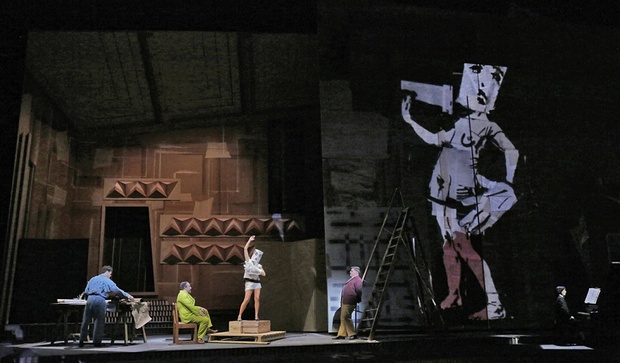We went to hear the opera "Lulu" at the Met in the new production by the artist William Kentridge. This is one of my favorite operas. In graduate school I took a seminar on it, and spent many months totally absorbed in the manifold mysteries of the score. It has been a long time since I heard it, though. It was stunning. Hearing Berg's music performed live by an orchestra of the caliber of the Met orchestra was a revelation, especially knowing all the melodies so well. The opera really works with leitmotifs; every character and idea has a tune. It is also what Adès calls a "symphony opera". The music is extremely fast and dense at times, and at other times it is very Mahlerian. Anthony Ross in the New Yorker quotes Adorno as saying that Berg's music is like Schoenberg's and Mahler's played at the same time. The singers were excellent, and the Lulu, Marlis Petersen, was truly extraordinary, singing what must be one of the most difficult roles in the repertory. Though I really hope that some day I have the chance to hear Barbara Hannigan in the role (she has done it in Brussels already).
Of course, the big news in the case of a new production is the new production. I have to say that I really didn't like the production, though it has received almost unanimous praise from the critics. My chief problem was the sensory overload; the sets have constantly changing video projections and animations that often detract from and dwarf the action on stage. There is also a mime figure who is constantly moving around on stage. I had no idea what purpose she served. People are putting paper masks on their heads, and then taking them off when they have to sing. Very distracting! Interestingly, Kentridge himself discussed this problem in an interview, admitting:
"All opera is about excess in its very nature, and, it's true of this production in particular, when you're in the opera house you've got an overload"
Well, that is one solution; if you have a musical score and libretto which is overloaded, then create a mise en scene that is overloaded too. It's the kitchen sink approach (everything but). This image gives you an idea of what it looked like. Imagine that projected images in the background are shifting all the time, and note the mime in the lower right hand corner who is also gyrating constantly while seated at a piano. And you really want to be focusing on the characters and what they are singing.
Admittedly, the projections are stunning; but it was all too much for me. I also had issues with the painting of Lulu, which is being created in the first scene, and is thereafter mentioned in the libretto when it shows up in later scenes; it is intended to show the image of the original Lulu in contrast to the constant degradation her character suffers during the course of the opera. There was no visible painting, and when it is referenced in the libretto, a very small brown paper is used to represent it. (I am beginning to sound like a crotchety old reviewer!). One final complaint. At the devastating end of the opera, when everyone is lying dead on stage and the music has incredible intensity, we suddenly get a large title projected on stage "Der Tanz is aus" i.e. "The dance is over". Well, duh! Why does Kentridge need to inject his text into that extraordinary moment when the music is so intense and profound?
End of rant, but I could go on with many other examples of things that bothered me. Fortunately, I was able to focus on the singers and the music (the acting was very good as well, and I give Kentridge credit for that) and the projections stayed away from my conscious perception.
More images:
One final note. This opera was written 80 years ago, and is, I think, still more shocking than anything being written today. Murder, greed, depravity, lust, etc.; it's all there. The character of Lulu is in many ways unfathomable, an endlessly complex enigma that allows no solutions. And in the end (spoiler!) everyone is murdered. And Berg's music is fully expressive of all these qualities, from the decadent and sensual saxophone melodies to the grand Mahlerian orchestral climaxes, it's all there in the music. Wow!




No comments:
Post a Comment